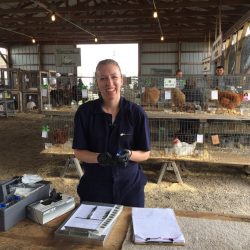By Liz Ritchie

When you hear the term “veterinarian,” which types of animals come to mind? A cat? A dog? Maybe a cow? Veterinarians work with several species. One of the newest species is the honey bee!
In 2017, the Food and Drug Administration (FDA) enacted the veterinary feed directive (VFD). This directive requires that farmers work with a licensed veterinarian when using a VFD drug, such as an antibiotic, in animal feed. This is yet another way that the agricultural industry is regulated so that we are provided food while public health is protected. This applies to beekeepers, because even though bees are insects, they can get diseases just like our other veterinary species!
Bees are affected by a vast list of diseases, but let’s highlight some of the main offenders. Varroa mites are a type of parasitic mite that feed on the adult bees. Unfortunately, these mites carry viruses that can weaken bees. A bacterial disease that can wipe out an entire bee hive is called American foulbrood. The bacteria responsible for this disease can produce millions of tiny spores that can live in even the harshest of weather conditions, making this pathogen extremely deadly for bees. Bees can be influenced by fungal sicknesses as well. Chalkbrood is a fungal disease that manifests in the gut of the bee larva and cause starvation.
With all of these honey bee diseases and this new feed directive, what exactly does this mean for beekeepers? If a beekeeper wants to treat a hive with antibiotics, they must have a professional working relationship with a veterinarian. After assessing the health of a hive, a veterinarian may prescribe antibiotics, which the beekeeper can have filled at a pharmacy. This means that the relationship between veterinarians and beekeepers just got stronger, and students at Michigan State University are preparing themselves for bee medicine.
Students at the College of Veterinary Medicine have formed the “Veterinary Medicine Bee Club” and are working with Dr. Meghan Milbrath, an academic specialist in the Department of Entomology at MSU and the coordinator of the Michigan Pollinator Initiative. Students realize the important role that veterinarians now have in combating honey bee diseases and are actively seeking hands-on hive skills until they are eligible to take a clinical rotation with Meghan in the summer after their third year of veterinary school.
There are many ways to get involved if you, too, want to help the honey bees. You can start by planting native plants that provide food sources for bees. Bees need flowers throughout the summer, so try to plant a variety of species that bloom at different times. More resources can be found online at pollinators.msu.edu. You do not need a veterinary degree to make a difference in the lives of our bees in Michigan. Everyone can get involved to improve the health of even the tiniest agricultural species.



